
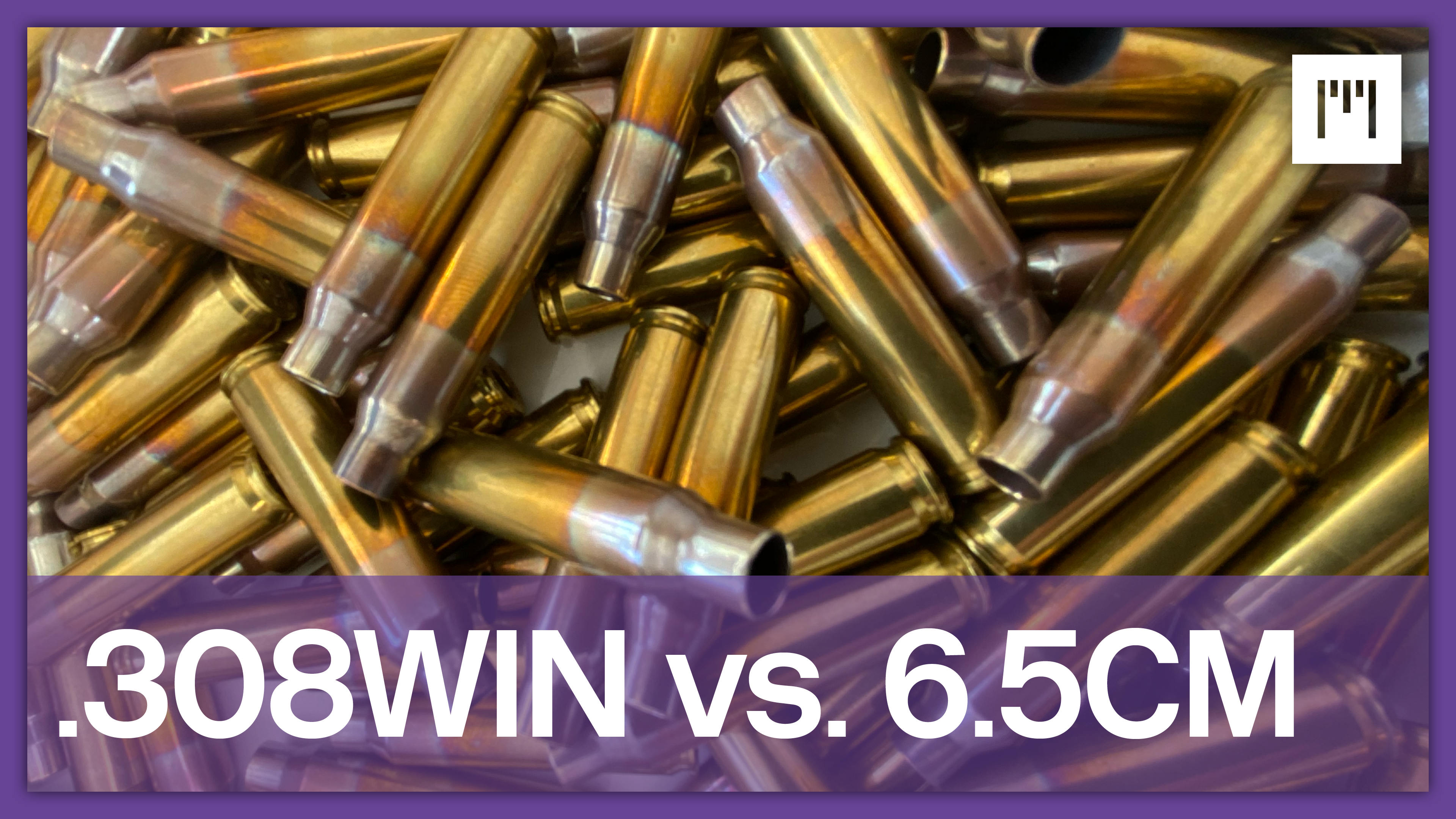
As a long time .308WIN shooter, I was a very early adopter of 6.5CM (6.5 Creedmoor), smitten & seduced like so many, by the promise of all those sexy high-BC bullets and their wind-cheating magic. As such I had a ring-side seat to watch events unfold as 6.5CM rocketed in popularity and to observe the spectacle of the following cultural backlash against it.
I’ve enjoyed all the self deprecating memes over the years and listened to all the claims and opinions, and whilst it seems as though I’m a little late to the .308WIN vs 6.5CM debate, I have a lot of hard-earned first-hand experience of the things commonly being discussed, and the debate itself is showing no signs of calming down – so here’s my tuppence worth…
To try and be a fair as a possible and avoid either calibre being judged on the merits of a single bullet alone, I looked at Hornady’s entire published load data for each calibre and calculated the energy that each bullet/load generated, in joules.
It’s a useful exercise that reveals which projectile performs the best in each calibre. Is there indeed a sweet-spot for each calibre? This exercise will confirm it.
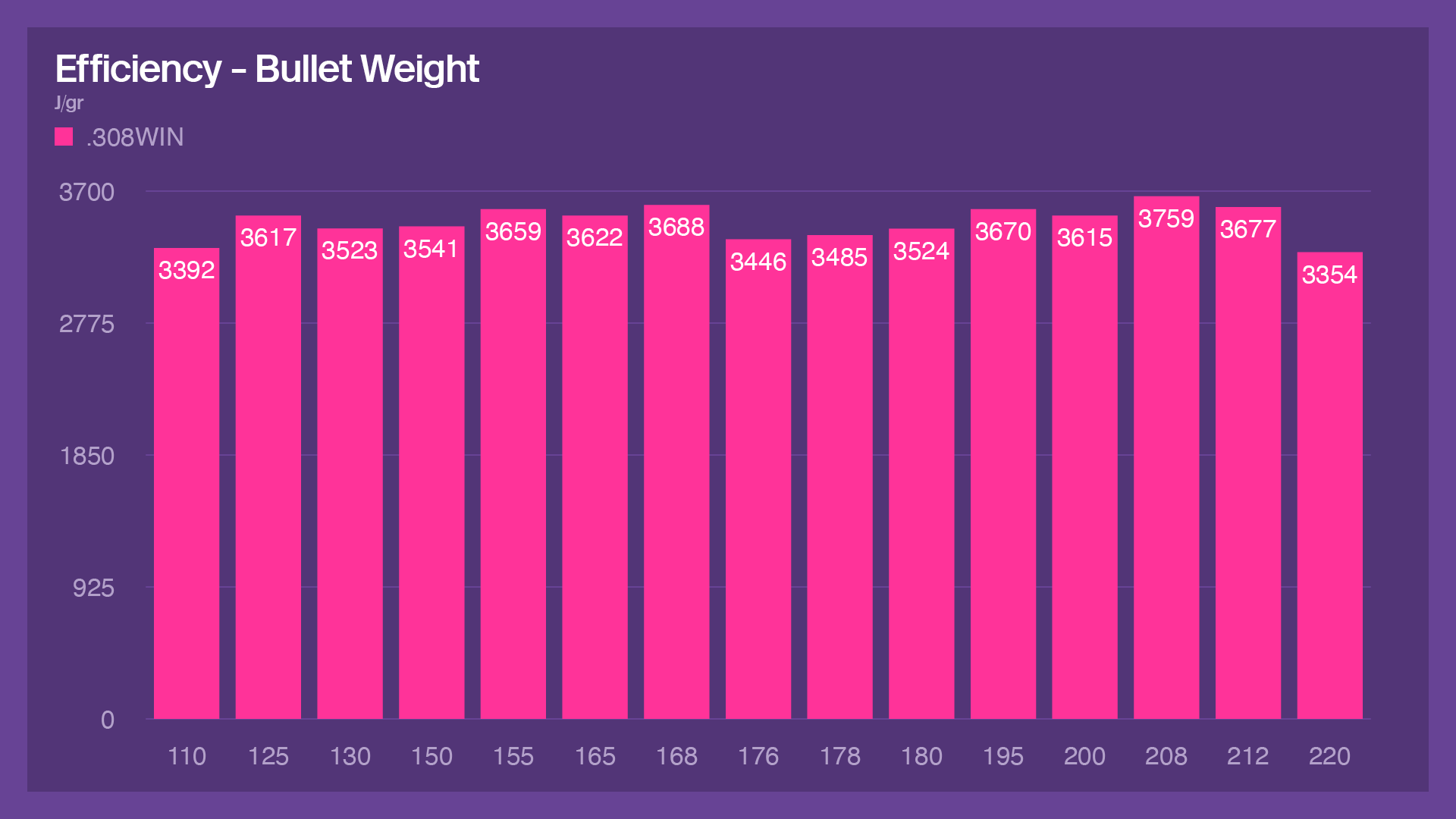
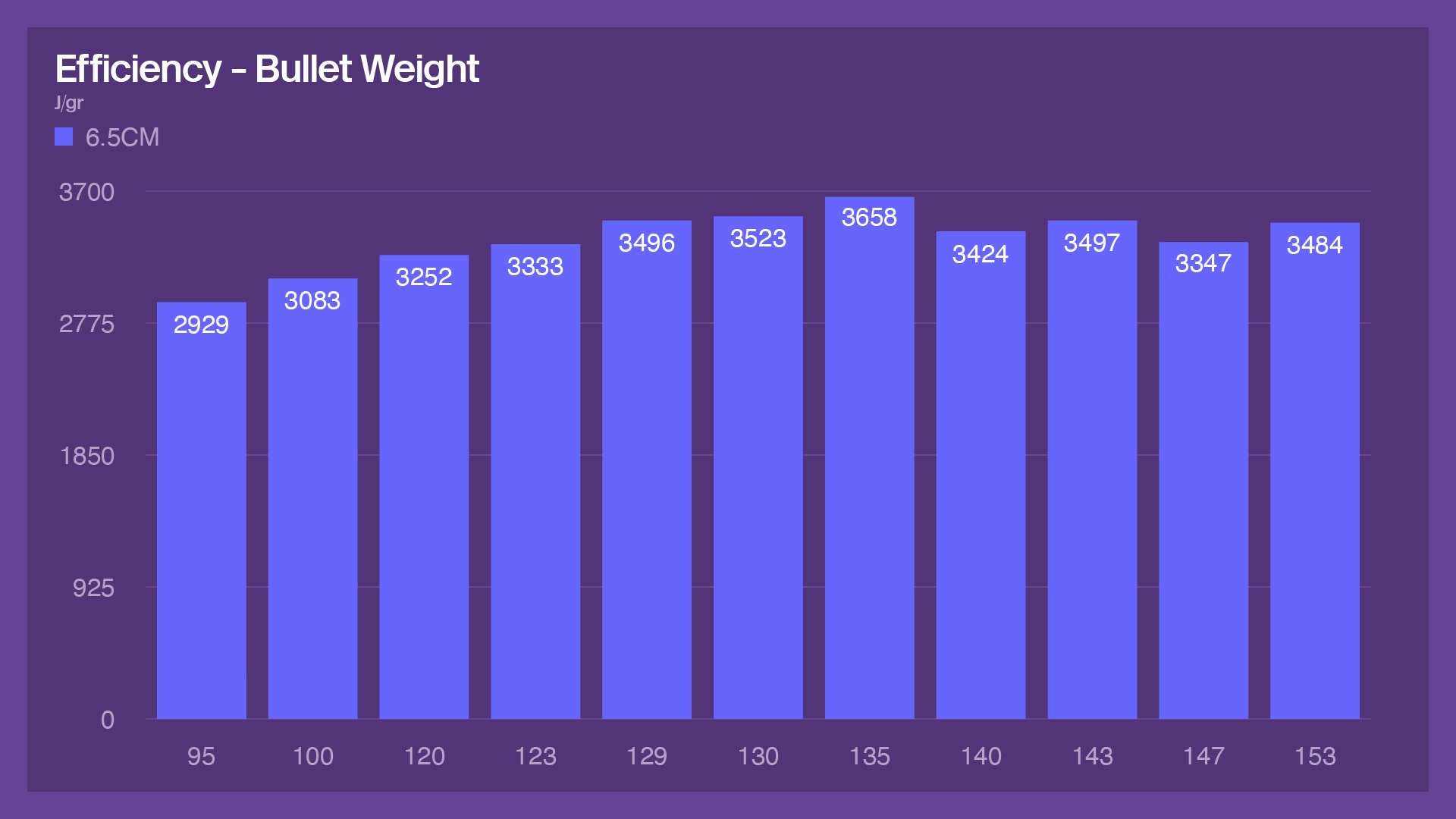
For .308WIN the highest performing load turned out to be the 208gr ELD-Match, which at 2,450fps generated 3,759 joules. For the 6.5CM it was the 135gr A-Tip Match, which at 3,000 fps generated 3,658 joules of energy. That's a 2% difference between the two highest performing loads - hardly chalk & cheese.
Had I simply picked two projectiles arbitrarily, there is a danger that I could have put a calibre at a false disadvantage.
It’s clear from this exercise that a number of different Hornady .308WIN projectiles emerge from the barrel with greater gusto than 6.5CM’s best projectile on it’s best day. Admittedly there’s not a lot in it, but technically .308 does have more energy at the muzzle than 6.5CM. So in my opinion that particular clubhouse ‘fact’ has been verified as true, if a little pedantic.
The second club house fact that you will often hear is that 6.5CM is ‘more efficient’. This breaks down into two parts: 1. Intelligent use of case capacity and how efficient the cartridge case geometry is at burning said propellant, and; 2. The BC of the projectile itself and how long it can hold on to its energy during the external ballistics phase.
In the 6.5CM, the 135gr A-Tip generates 3,658 joules of energy from a 46.0grn propellant charge. Which means that each grain of propellant generates 79.52 joules of energy.
In the .308WIN, the 208gr ELD-Match generates 3,759 joules of energy from a 44.6gr propellant charge. Which means that each grain of propellant generates 84.28 joules of energy.
This means that the 6.5CM burns its propellant with about 94% of the efficiency of the .308WIN. Again, not exactly an earth-shattering difference.
This confirms that .308WIN is doing more with each grain of propellant, and is therefore more efficient.
Of course, different propellants will produce different amounts of energy per grain. But remember we have selected each calibre's highest performing load/projectile, and subsequently the highest performing propellant for that projectile – so all that we can say is that .308WIN's highest performing load outperforms 6.5CM's highest performing load, in terms of propellant efficiency. So it's hard to see any evidence to support the claim that the 6.5CM is more efficient in this respect, at least.
So the argument that the 6.5CM case design is ‘more efficient’ in terms of powder burn clearly doesn’t seem to hold water. Ask those professing this greater efficiency what they mean exactly and you’ll most likely be met with vague mumblings, because there’s a very good chance they have no first-hand experience of the subject matter and they are simply parroting what they heard someone else saying.
There is then the assertion, that by seating the bullet out longer, the 6.5CMs case design is more efficient in that it makes better use of the available volume, as the tail of the bullet isn’t eating into the available case capacity. Whilst this is true, it does overlook the fact that the 6.5CM takes the .308WIN's shoulder and bumps it down, thereby reducing case capacity from 56gr to 52.5gr of H2O. In this respect the 6.5CM case is a bit like the opposite of an Ackley Improved cartridge – where a shoulder is sharpened in order to increase case capacity.
So whilst the 6.5CM does have the sharper shoulder which is so in vogue, and the tail of the bullet doesn't eat into the case capacity, pushing it down like this does result in a smaller capacity. You have to ask yourself what is the difference between a larger capacity and a bullet which eats into it – and a smaller capacity where the bullet doesn't eat into it? The bullet might not be eating into the 6.5CM's case capacity, but the sharper shoulder angle already has? Had the designers started with a .308WIN case and AI'd it's shoulder, thereby making it sharper and increasing the case capacity, then that case would have been a more efficient use of space. But that case would also result in a cartridge with a COAL greater than 2.800". In my opinion the .260REM AI makes more sense than the 6.5CM's design. Regardless, we can see from the real world results that the 6.5CM's case design yields no real world benefits - the .308WIN case design is simply burning its propellant with greater efficiency and the results can be measured at the muzzle.
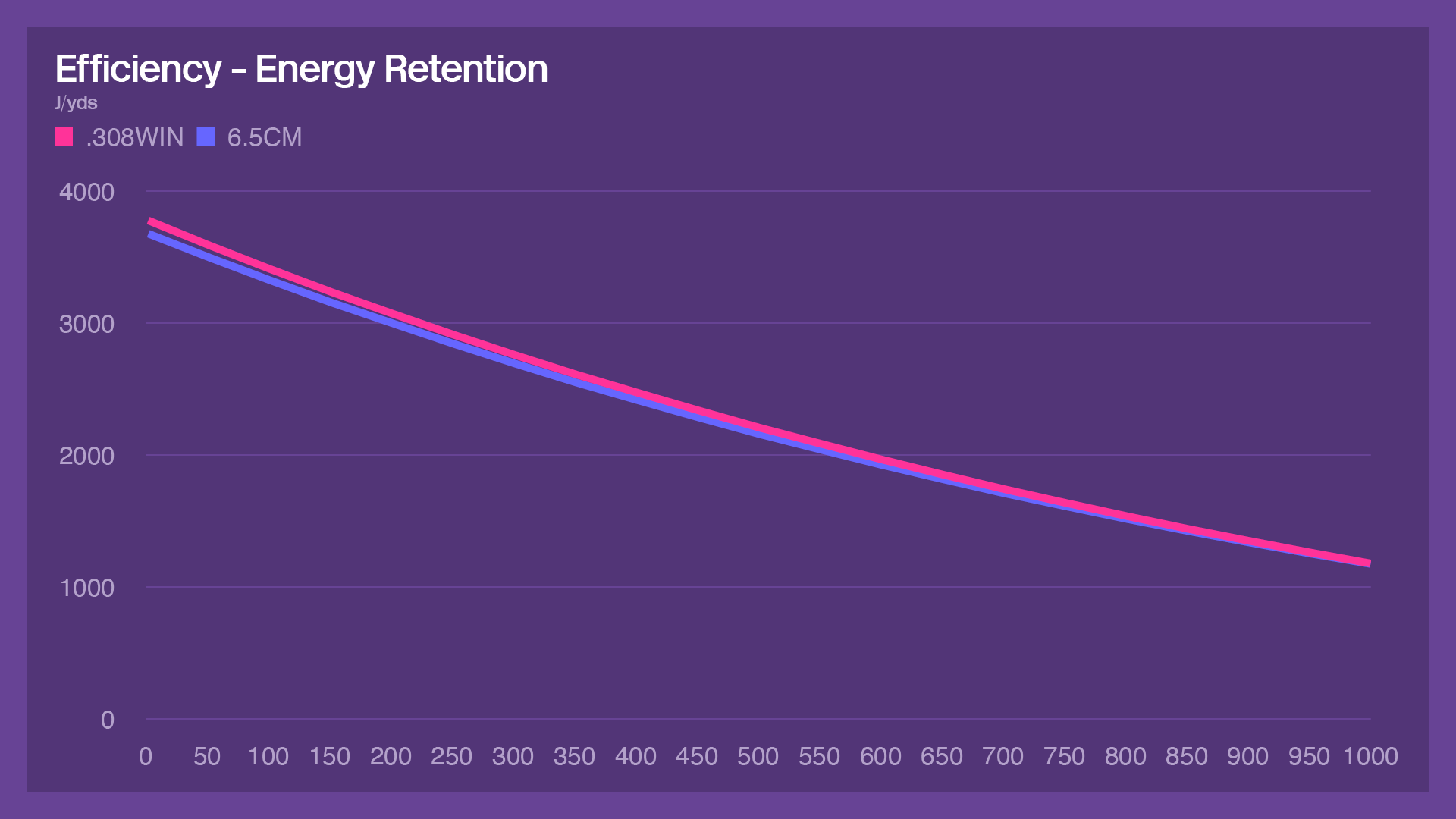
But let’s take a look at the second part of the efficiency claim - that 6.5CM projectiles are more efficient in flight, and therefore retain more of their energy down range. The .308WIN’s 208gr ELD-Match projectile has a G1 BC of 0.690, whereas the 6.5CM’s 135gr A-Tip Match has a G1 BC of 0.637. It looks as though the .308WIN has the edge here, but again the difference is a hair's breadth.
On paper, judging by BCs alone, it looks as though the .308WINs projectile is going to be more efficient in flight. But lets plot both in Strelok Pro and see how the results pan out, all the way out to 1,000yds.
At the muzzle the .308WIN has 3,758 joules and the 6.5CM has 3,658 joules. At 1,000 yards the .308WIN has retained 1,200 joules and the 6.5CM 1,198 joules. So if you wanted to be super-pedantic you could argue that the 6.5CM is starting to close the gap on its disadvantage at 1,000 yards, from a 100 joule disadvantage at the muzzle to a 2 joule disadvantage. But such an argument really would be the epitome of splitting hairs. It’s also true to say that at no point between 0—1,000yds does the 6.5CM beat the .308WIN in terms of energy.
In fact, looking at the results, the two cartridges are so tight that they might as well be one-and-the-same, and I suspect that individual propellant lot numbers and environmental factors will result in far larger variations than the difference between the two calibres themselves.
So in my option, the often heard assertion that the 6.5CM is a more efficient design than the .308WIN has no basis in fact. The .308WIN is more efficient in terms of powder burn than the 6.5CM, and it’s optimum projectile has a higher BC which beats the 6.5CM’s optimum projectile at every distance between 0—1,000yds.

Then of course there is the fact that the .308WIN’s 208gr ELD-Match projectile is travelling at 2,450fps compared to the 6.5CM’s 135gr A-Tip travelling at 3,000fps. Everything else being equal, the .308WIN’s projectile will take longer to get to a set distance, and as such, gravity will act on it for longer resulting in a greater drop.
Most of the shooting that I do is either at known ranges or in situations where I have access to a LRF (laser range finder) device which helps me in the knowing. My scope has an elevation turret that allows me to dial-in corrections, and if my ballistics data is robust and proven, it really doesn’t make much odds to me whether I’m dialing-in a 6MILS correction or a 4MILS. There will of course be circumstances where it is impractical to know distance to target each time, and in those conditions a flatter shooting calibre will provide a greater margin of error.
But in my experience I am more likely to miss due to misreading the wind than I am due to getting my drop wrong. And a 208gr projectile that behaves like a freight train in the wind is preferable to a super-fast lighter weight projectile that gets blown around easily.
However, that super-fast projectile is in flight for a shorter period of time, and so the wind has a shorter opportunity to deflect it's path. So the question now becomes at what point does the shorter flight time of the super-lightweight projectile beat the obstinate, slow, freight train bullet?
That is the million dollar question, and something that ballistics aficionados spend a great deal of time considering.
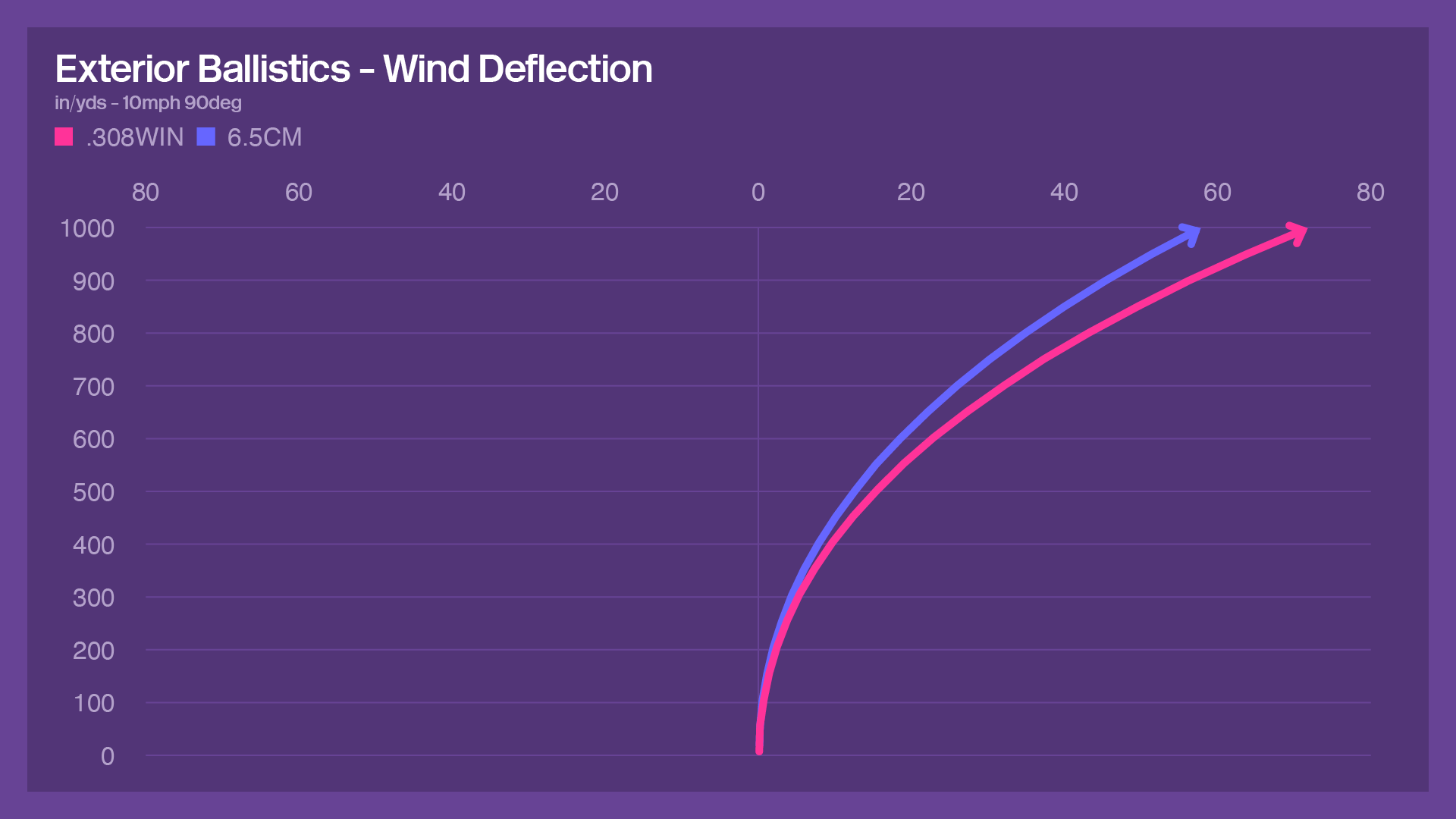
So now we come to the factor that has probably sold more people on 6.5CM that any other – wind deflection. Whilst the .308WIN 208gr ELD-Match may have a higher BC, the combination of the 6.5CM's impressive BC and greater velocity promises that the 135gr A-Tip Match will take less wind.
The experienced shooter knows that there is no such thing as a dead certain wind-hold. Every wind-hold is a guestimate to a greater or lesser degree. In these circumstances the projectile which is the most forgiving, represents a competitive advantage. And it is this attribute of 6.5CM which is perhaps the most convincing. Indeed for a lot of competitive 6.5CM shooters this wind deflection chart is the only one that matters.
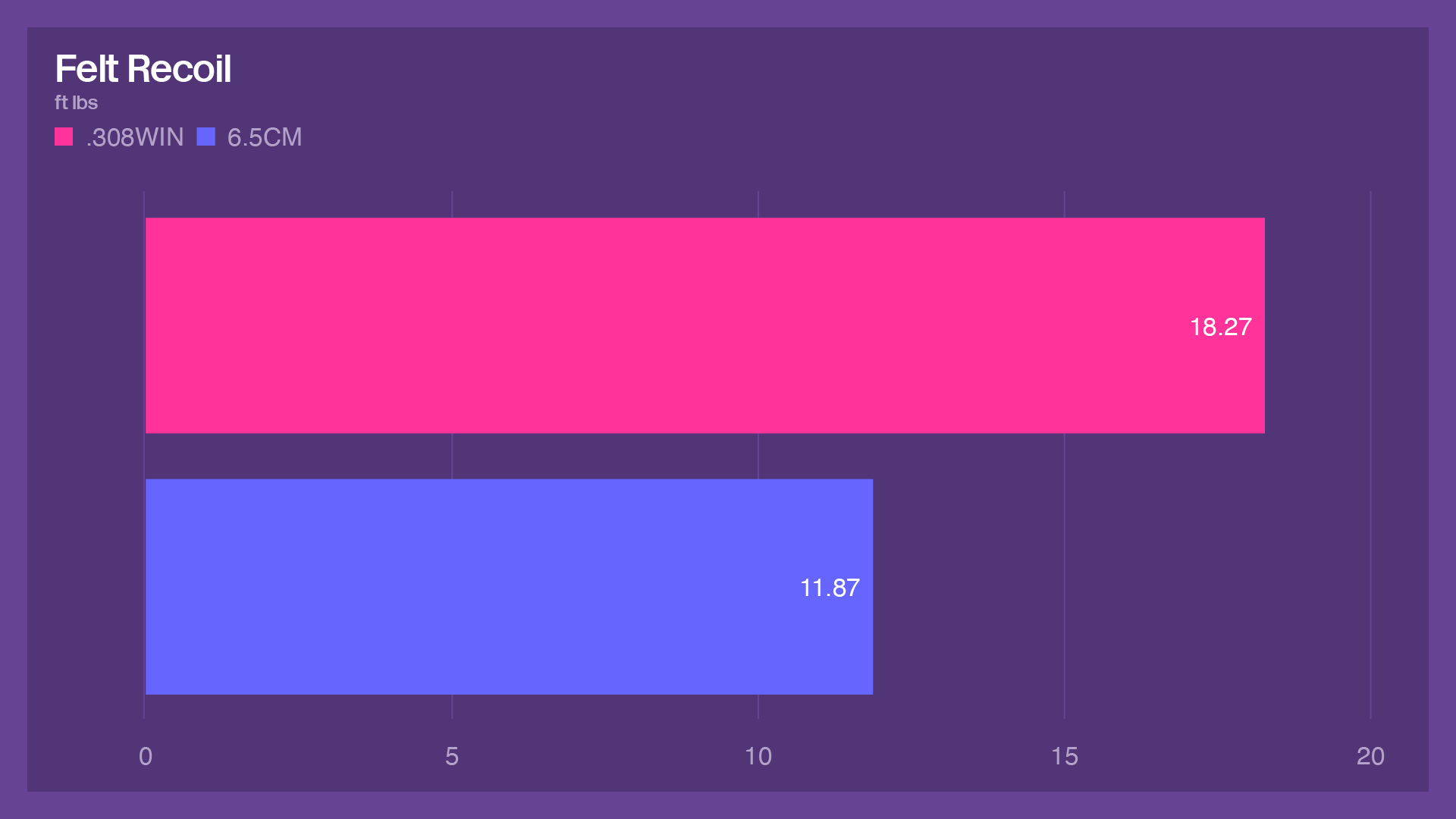
And lastly there is the claim that 6.5CM generates less felt recoil than the .308WIN. It is this particular claim that originally spawned all the goading about Creedmoor shooters having to ‘grow a pair’, jokes about cross-dressing man-bun types and Brokeback Mountain memes.
Felt recoil can be particularly challenging to quantify as whilst theoretical numbers can be calculated on a spreadsheet, real-world variables like rifle stock geometry, barrel/recoil axis and muzzle devices like brakes and moderators can have huge impact on felt recoil.
Bullet weight also has a huge effect on felt recoil. Newton's Third Law of Motion, also known as the law of action and reaction, states that for every action force, there is an equal and opposite reaction force. If you're pushing a heavier weight bullet down the barrel, you're going to experience proportionately greater recoil. So it's perhaps litte surprise that the .308WIN's 208gr bullet pushes you around more than the 6.5CM's 135gr bullet.
As chance would have it, I happened to have two identical RPRs chambered in .308WIN and 6.5CM handy for testing. RPRs are renowned for their easily managed in-line recoil path, and they both had the same barrel length and moderator (with calibre-optimised diffuser cores). Literally the only thing that was different about the two rifles was the diameter of the holes in the barrels. I even used the same scope, mount, bipod and magazine between the two rifles.
In real-world testing it is immediately obvious, and unarguably the case, that the 6.5CM has dramatically less recoil than the .308WIN. Furthermore the 6.5CM’s recoil pulse feels like a prolonged push, whereas the .308WIN’s recoil is delivered all at once in a sharp kick. It's not all about comfort. A lower felt recoil means that it's easier to observe the effect of your shot and make a quick follow-up shot if required. You soon get weary of losing your sight picture with every shot, only to waste time trying to reacquire your target.
Bullet weight aside, I personally think the .308WIN's heavier recoil this has to do with the .308WIN cartridge’s comparatively smaller shoulder and larger aperture which results in all the pressure being blown out in a ‘oner’, compared to the 6.5CM’s sharper/more defined shoulder and smaller aperture which results in the pressure being squirted out over a relatively longer period of time. In my mind it’s a bit like when you constrict the mouth of a garden hose between your thumb and forefinger and the increase in pressure results in an arc of water which goes a further distance.
Given that lower recoiling rifles are proven to be more accurate, this gives the 6.5CM a huge advantage in this area.
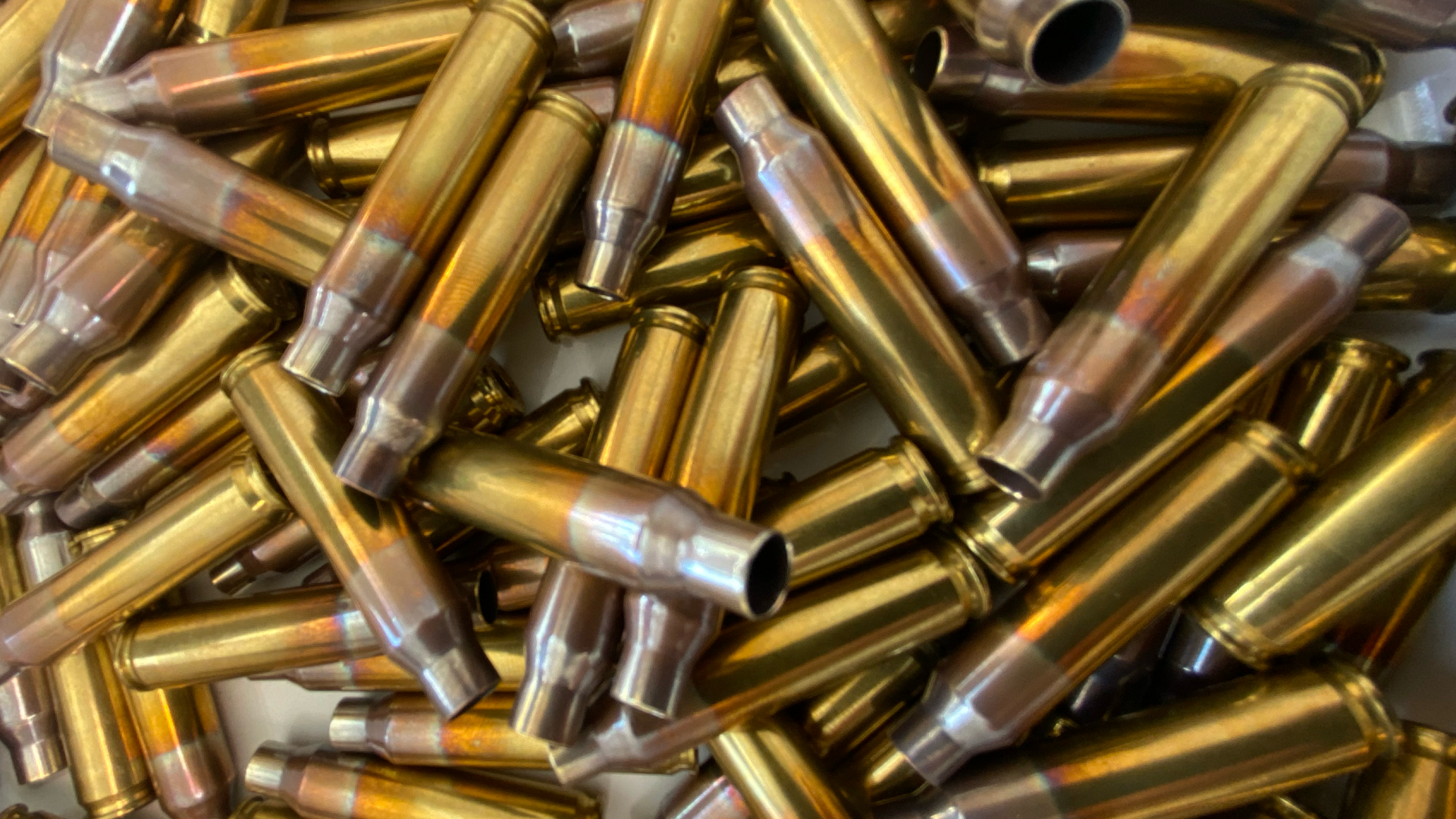
One other area, which isn’t discussed as much is that the .308WIN leaves larger holes in paper targets. This can give the .308WIN shooter two distinct advantages: 1. The .308WIN’s holes can still be observed through the scope at ranges where the 6.5CM’s holes are invisible. This gives the .308WIN shooter the advantage of being able to correct their aim during long range un-indicated matches; and 2. Where scoring-in is employed during marking of competitions the .308WIN shooter’s larger holes are more likely to break the line and score up the way.
In competitions where there are often ties, and V-bulls count, this can make the difference between your name, or someone else’s name, being engraved on the silverware.
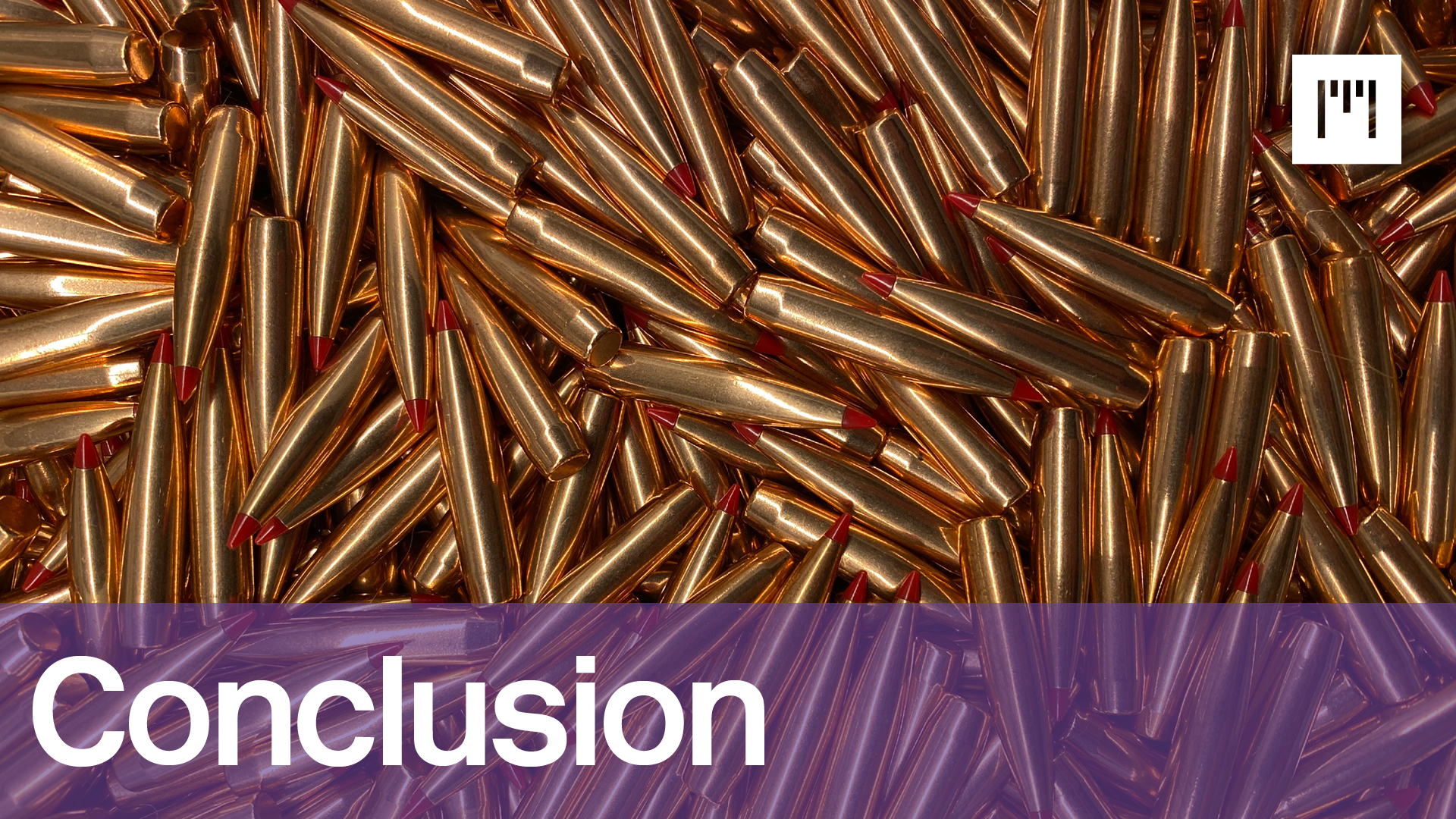
So in conclusion the .308WIN and 6.5CM have more in common than they have differences.
If you pick your components wisely, there is no real-world benefit to the 6.5CM’s ‘modern case design’ in terms of powder burn efficiency, energy developed, or in the ‘long, high BC, heavy for calibre projectiles’ in terms of their energy retention.
There is a demonstrable benefit to the 6.5CM's wind cheating capability, thanks to it's high BC bullets and faster pace. I would argue that this is the single biggest advantage that 6.5CM has over .308WIN.
.308WIN is cheaper to reload, thanks to the bustling demand around 6.5CM components (and the corresponding price gouge).
.308WIN performs better in shorter barrels, and has a longer barrel service life.
.308WIN’s holes are bigger on paper which can provide an edge when competing at long range.
It is easier to manage 6.5CM’s recoil, which provides a distinct advantage in itself, and it is ultimately simply more enjoyable to shoot.
All-in-all, having owned and shot both calibres extensively, I don’t really see there being a right or wrong answer in the .308WIN vs 6.5CM debate. I see it more as two cartridges whose performance in the real world is as close to identical as you are likely to find. I see it more as a win/win scenario.
There is an argument, that the 6.5CM can do all that the .308WIN can do, and do it with considerably less recoil, a flatter trajectory and less wind deflection. I would agree with this, to some degree, but I do think that a lot of the talk about a 'more efficient case design' etc. is hype. Likewise whilst it is true that the 6.5CM does retain more of it's original energy downrange than the .308WIN, it is again all academic as it never actually betters its .30cal cousin (at least out to 1,000yds anyway). And there again, .308WIN is easier to course-correct on un-indicated competitions. I could go back and forth all day.
Either cartridge will do you proud, and as always, whichever option you go with, practicing and knowing your choice of rifle & ammunition inside-out will provide you with an unassailable advantage over anybody else who picked ‘the other option’, but neglected to practice.
It’s not the sexiest conclusion, but it is one based in fact and devoid of emotion or hype. Whichever calibre you choose personally – enjoy your shooting!